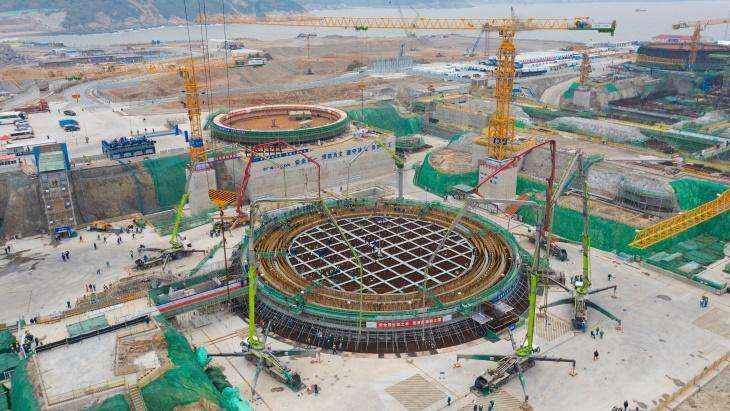Call Toll Free +1 855-856-TIPS
Charlestown, West Virginia – The governor of West Virginia has now received a bill to overturn a ban on the development of nuclear power plants in the State.
A Vote of 76 to 18 was recorded in the House of Delegates on Monday to approve the Senate bill.
The bill’s supporters claimed that compact modular reactors have advanced in technology. Stating nuclear power facilities that are being developed today are safer and more efficient than those that were built in the past.
Bill Supporters
According to Del. Guy Ward, R-Marion, “The nuclear power plants that they are designing today are much safer, much more efficient. They’re actually smaller than the units that were producing back in the 70s and 80s and about half the size,” Del. Guy Ward, R-Marion, said in a statement reported by WCHS.
As a power plant worker for almost 33 years, Ward claims to have some knowledge of nuclear power.
“I prefer coal over nuclear, of course, but we need these additional plants because take a 2500-megawatts out of your system, that really makes your grid fragile. We need to take this ban away because nuclear is safe,” Ward said. Ward insisted to WCHS in their report.
Bill Opponents
There was a fear that the radioactive waste might remain deadly for hundreds of years if the restriction was lifted. Removing the moratorium, say opponents, would exacerbate the problem of disposing of nuclear waste, while proponents argue that the power plants are critical to West Virginia’s efforts to attract new businesses.
In 1996, the state of West Virginia voted to end nuclear power production. Raising the restriction, according to Del. Brandon Steele, R-Raleigh, will allow the state to have a discussion about whether or not it fits into an energy strategy that emphasizes “all-of-the-above”
Is Nuclear Power Safe And More Advanced?
We have yet to see fool proof ideas with unintended consequences in Nuclear power recently and have read a lot about the misfortune around the world when things go wrong. The United States has had more resources focused on Fusion, Hydrogen, Oceanic Power, Solar and Wind. There has hardly been a race to Nuclear.
Nuclear Regulatory Commission Rejects Proposed “NEW SAFE” Plant On January 6, 2022
Oklo Power LLC’s application to construct and operate a 1.5 megawatt fast reactor in Idaho was denied by the Nuclear Regulatory Commission. The business model Oklo has hopes to secure permits for small modular reactors (SMRs) that could replace the current nuclear fleet’s massive light-water reactors. The Indian Point Energy Center in Buchanan, New York, was shut down last year, is one example of a light-water reactor that has been shut down.
The Commision’s decision stated that Oklo’s application still has severe information gaps in its description of Aurora’s potential mishaps and its classification of safety systems and components according to the NRC’s findings. Oklo’s application was rejected without prejudice and is free to submit a complete application in the future.
Bargaining Chip For Republicans?
Development and construction could be years out with the scrutiny of oversight committees. It is possible this is a push from the West Virginian Republicans as the Biden Administration now has to circle back in order to continue the push for their Chip Bill and Build Back Better programs.
Although not in a Nuclear Power race with China supporters of these new plants say we should be. Whether this is true is yet to be seen. Technology advancement of renewable energy and other clean energy has been advancing at a record pace not seen before. Approvals could take 5 years or possibly longer for a new nuclear plant, in that time its possible nuclear may not even the be relevant.
Coal-fired power facilities in China and elsewhere have been leaning towards high-temperature gas reactors (HTGRs) as the “Alternative”. For more than two decades, Chinese businesses have been developing HTGRs. World Nuclear News reports that both reactors at the Shandong plant reached criticality in September and November respectively. On the 20th of December, the plant’s electricity production began to flow onto the grid.
China
China has been developing and constructing new nuclear designs that are stated to be safer and more adaptable than the reactors already in operation. Bloomberg reports that China currently has 46 nuclear reactors in the works or planned. There are currently two reactors under development in the United States.
China’s San’ao Nuclear Plant Pours First Safety Concrete

China General Nuclear (CGN) announced in early January that the first safety-related concrete has been laid for the nuclear island of unit 2 at the San’ao nuclear power facility. It officially kicks off construction of the second of six Hualong One pressurized water reactors planned for the site in Zhejiang province, China.
The National Energy Administration approved the San’ao plant in May 2015. On 2 September 2020, the State Council’s executive meeting approved the building of units 1 and 2 as the plant’s initial phase. On 30 December of that year, China’s National Nuclear Safety Administration issued a construction license for the two units, and the following day, the first concrete for unit 1 was laid.
San’ao 1 and 2 are expected to commence energy production in 2026 and 2027, respectively.
Once all six units at San’ao are operational, yearly power generation capacity will reach 52.5 billion kWh, surpassing Wenzhou’s annual electricity consumption in 2020, CGN reported. They state the plant may reduce annual coal use by nearly 16 million tonnes and carbon dioxide emissions by 43.36 million tonnes.
The San’ao project is the first in China to include private financing, with Geely Technology Group acquiring a 2% interest in the factory. CGN owns 46% of the project business Cangnan Nuclear Power, with the remaining held by other state-owned enterprises.
CGN now has seven nuclear power reactors under construction with a combined capacity of 8.3 GWe, following the formal commencement of construction of San’ao 2. It now operates 25 units with a combined capacity of 28.26 GWe.
United States Firms & Japanese Firms To Cooperate On Fast Reactors
The Japan Atomic Energy Agency (JAEA), Mitsubishi Heavy Industries (MHI), and Mitsubishi FBR Systems (MFBR) signed an agreement with TerraPower of the United States of America to collaborate on the development of sodium-cooled fast reactors last week. TerraPower, founded by Bill Gates, is building a sodium-cooled fast reactor called the Natrium.

According to the JAEA, Japan seeks to accelerate innovation in a variety of nuclear technologies through collaboration with foreign partners developing next-generation revolutionary reactors. With the support of the US Department of Energy (DOE) they are attempting to promote fast reactor development cooperation with the US, which is attempting to lead the world by initiating the development of a fourth generation reactor, including a sodium-cooled fast reactor, through its Advanced Reactor Demonstration Program (ARDP).
A Memorandum of Understanding regarding TerraPower’s cooperation in the development of Natrium is the first step of cooperation in the development of sodium-cooled fast reactor technology in Japan and the United States.
JAEA has a history of operating sodium-cooled fast reactors, including Monju in Fukui Prefecture and Ibaraki Prefecture’s Joyo experimental fast reactor. However, Japan’s fast reactor research has been suspended since the government opted to decommission Monju in 2016 due to a series of difficulties, including a sodium coolant leak in 1995.
Concentrating on manufacturing technology, JAEA, MHI, MFBR, and TerraPower have exchanged knowledge on their respective technologies as well as sodium-cooled reactor-specific technologies such as refueling machines and defective fuel detecting systems.
TerraPower stated that it acquired JAEA’s fast reactor know-how and test facilities through Joyo, Monju, and the Japan Sodium-cooled Fast Reactor idea for the next-generation fast reactor, among others, as well as equipment design from Japanese firms, in order to begin operating Natrium.
TerraPower has been selected by DOE to receive cost-shared funding under the Advanced Reactor Development Program (ARDP) to test, license, and build an advanced reactor within the next seven years.
The business has chosen Kemmerer, Wyoming, as the ideal location for its nuclear power plant demonstration project, which will include a 345 MWe sodium-cooled fast reactor and a molten salt-based energy storage technology. When needed, the storage technology may temporarily enhance the system’s output to 500 MWe, allowing the plant to adapt to daily changes in electric load and smoothly integrate with variable renewable energy sources.
EPA Moves To Restore Obama-Era Rules On Power Plants Today
In another move Monday the EPA took steps to restore and possibly expand EPA regulations when it comes to power plants and possibly other infrastructure similar. Although in the current form the regulations are geared toward coal powered plants. It is a signal that the regulation is up for more wide ranging scrutiny.
In 2020, the Trump administration undermined the Mercury and Air Toxics Standards (MATS) rule by altering its legal basis, making it more subject to challenges. The MATS rule, in general, limits the amount of harmful pollutants that coal and oil power stations can emit into the atmosphere.
Mercury is a neurotoxic that is especially dangerous to kids.
Neither the 2020 rule nor the action taken on Monday changed the Obama-era criteria. Instead, the Biden administration proposed on Monday to confirm that regulating emissions of these pollutants from power plants is “appropriate and essential,” whereas the Trump administration had claimed that the restrictions were not suitable or necessary.
EPA Administrator Michael Regan and the EPA have been actively dedicated to aggressively lowering pollution from the electricity industry promoting clean air and for people to live healthy and productive lives. The standards are projected to have avoided between 4,200 and 11,000 premature deaths per year, according to the EPA’s website.
Critics claimed at the time that the Trump administration was seeking to provide polluters who wanted to sue to overturn the rules an unfair legal advantage. Following the revisions, a coal company filed a lawsuit challenging the MATS rule.



